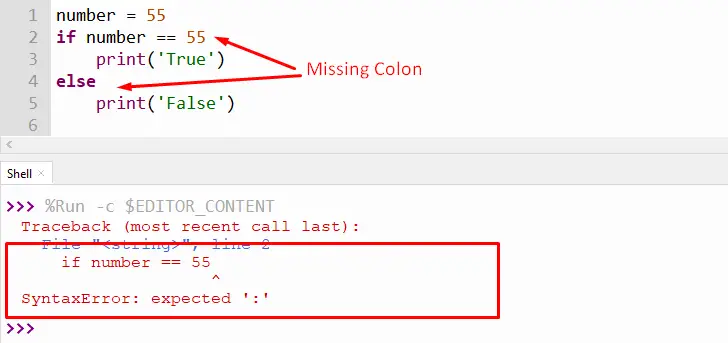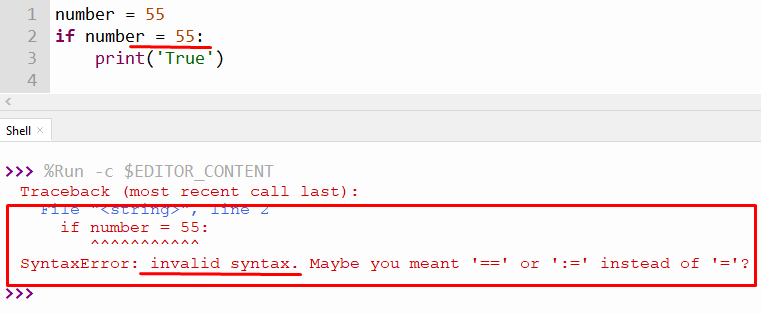Syntax is the key component of any programming language, and if it is not followed correctly, you will not be able to execute the code. The same goes with Python; the “invalid syntax in if statement” error arises when the if statement syntax is not followed correctly.
This Python write-up will provide a complete guide on rectifying the “SyntaxError: invalid syntax”. The content served in this post is:
- Reason 1: Missing Colon at the End of if Statement
- Solution: End if Statement With Colon
- Reason 2: Using Single Equal Sign
- Solution: Use Double Equal Sign
- Reason 3: Incorrect Indentation
- Solution: Correct the Indentation
Reason 1: Missing Colon at the End of if Statement
The prominent reason which causes this error in Python is when the user forgets to add the colon at the end of the “if” and “else” statement. As an example, here is what I mean:

The above snippet is “SyntaxError” because the colon is placed at the end of the “if” and “else” statements.
Solution: End if Statement With Colon
To rectify this error, use the colon at the end of the “if” and “else” statement.
Let’s look at the following code that uses a colon at the end:
Code:
number = 55
if number == 55:
print('True')
else:
print('False')
In the above code, the colon “:” is used at the end of “if” and “else” statements to remove syntax errors.
Output:

The result is generated successfully without any syntax error in the program.
Reason 2: Using Single Equal Sign
Another reason is when the user uses a single equal sign rather than a double equal sign while comparing in the “if” statement.

The above output shows an invalid syntax error because the “Single Equal” sign is used instead of the “Double Equal” sign in the “if” statement.
Solution: Use Double Equal Sign
To resolve this error, use a double equal sign instead of a single sign while comparing any values in the “if” statement. The below-given code is the correct one and produces an accurate result without any errors:
Code:
number = 55
if number == 55:
print('True')
In the above code, the double equal sign is used to compare the conditions instead of a single equal sign.
Output:

The above output shows the result when the “if” statement condition becomes “True”.
Reason 3: Incorrect Indentation
Another common reason which causes this error in Python is using incorrect indentation while initializing the “if” and “else” statement. As an example, here is what I mean:

The above snippet shows the “SyntaxError” because the “else” block is indented incorrectly in a program.
Solution: Correct the Indentation
To rectify this error make sure to correct the indent while initializing the “if” and “else” statement. The “if” and “else” statements must follow an in-lined indentation at the same level. For instance, let’s have a look at the below-given code:
Code:
number = 45
if number == 55:
print('True')
else:
print('False')
In the above code, the indentation of the “else” statement is corrected and inlined at the same level as the “if” statement in the program.
Output:

The above statement successfully shows the value of the “else” block after the correcting indentation.
Conclusion
The “SyntaxError” arises when the user forgets to add a colon at the end of the “if-else” statement, incorrect indentation, or uses a single sign while comparing. To rectify this error, use a double sign while comparing, correctly indent the if-else statement, and always end the “if-else” statement with a colon. This article presented various reasons and solutions regarding the “SyntaxError: invalid syntax” in Python “if” statement with numerous examples.
